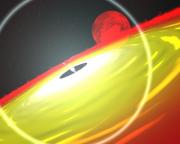Neutron Stars in Binaries
Little known Astronomy facts (secrets): When neutron stars were first discovered by astronomers, they were called 'LGM' - for Little Green Men. This was because they were found be be sending out very fast, very bright, periodic radio pulses, and different ones were pulsing at different speeds - they actually looked like they might be space beacons, similar to lighthouses, that space-faring LGM were using as navigational aids. We know now that they are a perfectly natural (not engineered) phenomenon, but they are still highly interesting and exotic. A neutron star contains the entire mass of the sun compressed into a ball only 20km in diameter - size of a city. They are as dense as if you took all the water in Cape Cod Bay and squeezed it into a single tear-drop. The density exceeds that in the center of an atomic nucleus and exceeds that which can be manufactured at the center of the biggest atomic accelerators (atom-smashers).
Often Neutron Stars capture a normal, solar type star nearby and tear gas of the more normal star. This gas heat up to X-ray temperatures as it falls onto the surface of the neutron star. When enough gas collects on the surface of the neutron star, it explodes and a bright burst of x-rays are seen. Some of the first discoveries of these bursts were made by researchers at the CfA (among them, Prof. Jonathan Grindlay). Today researchers measure the mass and radius of neutron stars, measure their spin periods, search for new neutron stars, and attempt to discover new places where they may lurk.
Saku Vrtilek, Peter Edmonds, Jose Galache, Jonathan Grindlay, Julia Lee, Frank Primini, Ping Zhao




